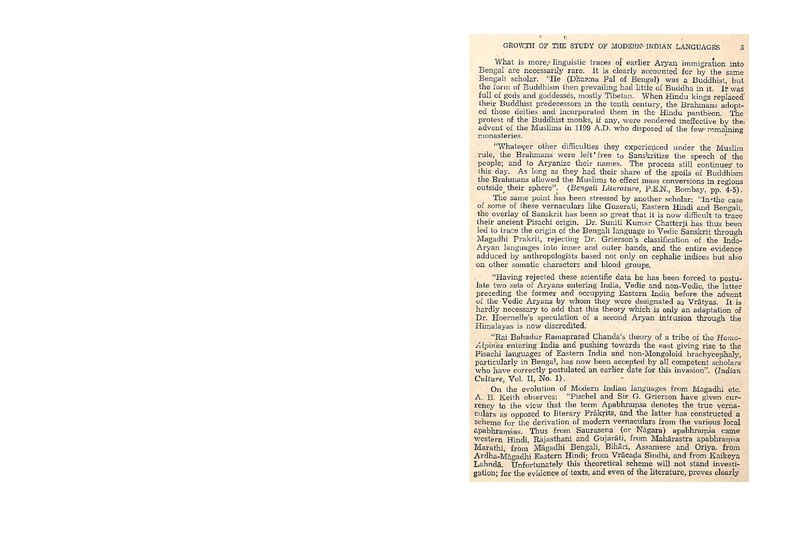GROWTH OY TILE STUDY OY SCODERN INDIAN LANGUAGES S What is more linguistic traces of earlier Aryan Immigration into Bengal are necessarily rare. It is clearly accounted for by the same Bengali scholar. "Ile (Dan Pal of Bengal) was a Buddhist, but the form of Buddhism then prevailing had little of Buddha in it. It was full of gods and goddessds, mostly Tibetan. When Hindu kings replaced their Buddhist predecessors in the tenth century, the Brahmans adopt- od those deities anil Incorporated them in the Hindu pantheon. The protest of the Buddhist monks, if any, were rendered ineffective by the advent of the Muslims in 1199 A.D. who disposed of the few remaining monasteries "Whatever other difficulties they experienlond under the Muslim rule, the Brahmans were left'iree to Sanskritize the speech of the people, and to Aryanise their names. The process still continues to ihis day. As long as they had their share of the spoils of Buddhism the Brahmans allowed the Muslims to effect mass conversions in regions outside their sphere" (Bengali Literature, P.EN., Bombay, pp. 4-5) The same point has been stressed by another scholar: "In the case of some of there vernaculars like Grati, Eastern Hindi and Bengali the overlay of Sanskrit has been so great that it is now difficult to trace their ancient Prochi origin. Dr. Suniti Kumar Chatterji has thus beun led to trace the origin of the Bengali language to Vedie Sanslerit through Magadhi Prakrit, rejecting Dr. Grierson's classification of the Indo- Aryan languages into inner and outer bands, and the entire evidence adduced by anthropologists based not only on cephalic indices but also on other somatic characters and blood groups "Having rejected these scientifie data he has been forced to postu. late two sale of Aryans entering India, Vedie and non-Vedie, the latter preceding the former and occupying Eastern India before the advent of the Vedic Aryans by whom they were designated as Vratyas. It is hardly necessary to add that this theory which is only an adaptation of Dr. Hoernelle's speculation of a second Aryan intrusion through the Himalayas is now discredited. "Rat Bahadur Ramaprasad Chanda's theory of a tribe of the Homo Alpines entering India and pushing towards the east giving rise to the Pisachi languages of Eastern India and non-Mongoloid brachycephaly, particularly in Bengal, has now been accepted by all competent scholars who have correctly postulated an earlier date for this invasion". (Indian Culture, Vol. II, No. 1). On the evolution of Modern Indian languages from Magadhi etc. 4. B. Keith observes: "Pischel and Sir G. Grierson have Xiven cur rency to the view that the term Apabhraupsa denotes the true yera. tulars as opposed to literary Prikrits, and the latter his constructed a scheme for the derivation of modern vernaculars from the various local apabhrarás. Thus from Saurasena (or Nagara) apabhrapia come western Hindi, Rajasthan: and Gujarati, from Maharastra apabhrama Marathi, from Magadhi Bengali, Bihari Assamese and Oriya from Ardha-Magadh Eastern Hindi: from Vricada Sindhi, and from Kadleya Lahnda. Unfortunately this theoretical scheme will not stand investi- gation for the evidence of texts, and even of the literature, proves clearly
Page:Growth of Asamiya Language.pdf/15
This page needs to be proofread.
